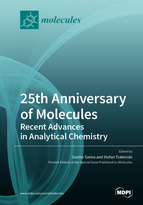25th Anniversary of Molecules—Recent Advances in Analytical Chemistry
A special issue of Molecules (ISSN 1420-3049). This special issue belongs to the section "Analytical Chemistry".
Deadline for manuscript submissions: closed (31 March 2021) | Viewed by 65280
Special Issue Editors
Interests: analytical chemistry; validation of analytical methods; chemometrics and data analysis; environmental chemistry and monitoring; food chemistry and analysis; speciation analysis; science of materials; electroanalytical methods; sensors and biosensors; modification of electrode surfaces; gas-chromatography; liquid chromatography; hyphenated methods; ICP-MS methods; FT-IR methods; determination of trace analytes in foods; food georeferencing and traceability; bioaccumulation of toxic elements in cereals; synthesis and characterization of conductive polymers; biomedical analysis in dental research; studies of equilibria in solution between metal ions and ligands of biological interest; ability of vegetal biomasses in removal of organic pollutants by wastewaters
Special Issues, Collections and Topics in MDPI journals
Interests: chemometrics; environmental analytical chemistry; intelligent data analysis
Special Issues, Collections and Topics in MDPI journals
Special Issue Information
Dear Colleagues,
In 2020, we are celebrating the 25th anniversary of our journal Molecules. To date, the journal has published more than 20,000 papers, and the journal website attracts 115,000 monthly visits and more than 395,000 monthly page-views. Our sincerest thanks go to our readers, innumerable authors, anonymous peer reviewers, editors, and all the people working in some way for the journal who have joined their efforts for years. Without your help, we would never have achieved this.
To mark this important milestone, a Special Issue entitled “Recent Advances in Analytical Chemistry” is being launched. This Special Issue collects full papers and high-quality review papers in all fields of Analytical Chemistry. We mainly encourage the submission of studies devoted to the assessment of new analytical methods (and/or analytical techniques, and/or chemometric tools), their validation and their application to a real case. We kindly encourage the Colleagues involved in all branches of Analytical Chemistry to make contributions to this Special Issue.
Prof. Dr. Gavino Sanna
Prof. Dr. Stefan Tsakovski
Guest Editors
Manuscript Submission Information
Manuscripts should be submitted online at www.mdpi.com by registering and logging in to this website. Once you are registered, click here to go to the submission form. Manuscripts can be submitted until the deadline. All submissions that pass pre-check are peer-reviewed. Accepted papers will be published continuously in the journal (as soon as accepted) and will be listed together on the special issue website. Research articles, review articles as well as short communications are invited. For planned papers, a title and short abstract (about 100 words) can be sent to the Editorial Office for announcement on this website.
Submitted manuscripts should not have been published previously, nor be under consideration for publication elsewhere (except conference proceedings papers). All manuscripts are thoroughly refereed through a single-blind peer-review process. A guide for authors and other relevant information for submission of manuscripts is available on the Instructions for Authors page. Molecules is an international peer-reviewed open access semimonthly journal published by MDPI.
Please visit the Instructions for Authors page before submitting a manuscript. The Article Processing Charge (APC) for publication in this open access journal is 2700 CHF (Swiss Francs). Submitted papers should be well formatted and use good English. Authors may use MDPI's English editing service prior to publication or during author revisions.









